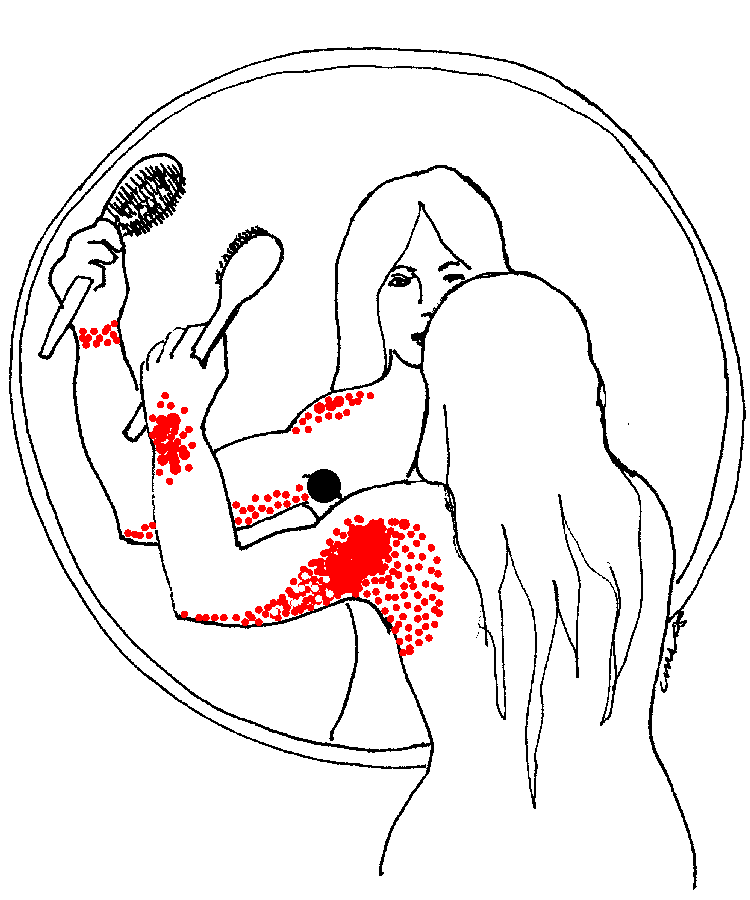Myofascial PainMuscles and Pain: Knee Pain, Backaches, Headaches, Even Carpal Tunnel Syndrome!Many common pains, from knee pain and back pain (including some forms of arthritis and other joint problems) to head and neck pain, can be traced to muscles and fascia. Myofascial pain is pain originating in muscle or fascia (rather than pain from disease or inflammation, such as kidney stones or a swollen appendix). Fascia ("FASH-uh")is the connective tissue that surrounds every structure of the body like a shrink-wrap leotard. In general it has a tensile strength of around 2,000 psi (pounds per square inch) rising to 4,000 psi in the scalp and head. It is the organic equivalent of the steel belting in radial tires. It is piezoelectric, meaning that it produces electrical charge under pressure, a property thought to be involved in its ability to refer pain over long distances. Muscles have been largely ignored in standard medicine, in favor
of cutting through them to get to the internal organs believed to be causing a problem.
But in fact, muscles are organs -- the largest organ system of the body,
variously estimated at around 50-70% of body weight.
And individual muscles produce remarkably individual pain patterns, commonly
sending pain to other areas of the body ("referred pain") far
from the actual point of origin. Over 80% of the time, the point
where you hurt is not why you hurt; it is not the source of the pain.
One of the strangest examples of muscles that refer pain over long distances is the soleus muscle of the calf. It has no muscular or neurological connection to the upper body, yet can send pain to the sacrum in the lower back and to the face. it may be hard to believe that high heels can cause jaw pain, but it is often true. Another strange but common example is the subscapularis muscle the lies under the scapula (shoulder blade). It is strongly involved in "frozen shoulder" and may keep you from combing your hair. But its remarkable pain pattern is puffiness on the back of the hand and a bracelet-like band of pain around the wrist. Together, muscle and fascia can misalign bones, produce mechanical and postural distortions, compartment syndromes, adhesions, cause severe pain and eventually joint damage. Much of this is due to entrapment of nerves and blood vessels. Nerves and blood vessels. We tend to think of "pinched nerves" as nerves caught between two bloody jagged ends of bones. That is car-wreck emergency-room trauma and far less common than their being caught -- strangled -- between a shortened, thickened muscle and its bony surroundings or within the tight muscle itself. Entrapment is common and it disrupts nerve messages and reduces blood supply producing numbness and tingling. For example, the leading cause of the symptoms of carpal tunnel syndrome is nerve entrapment by muscles especially the scalenes of the neck (the brachial plexus, the upstream electrical supply for the arm winds through these muscles), the pectoralis minor muscle of the chest (the nerve and blood supply must slip between muscle and ribs), and the pronator teres of the elbow (where the median nerve travels through the muscle itself). Actual nerve entrapment by the carpal tunnel itself is relatively rare. However, muscles aren't everything. Numbness and tingling are also symptoms of stroke or nerve damage. Always have such symptoms checked by a physician. Trigger Points are areas of shortened, hyper-sensitive muscle fibers named for their ability to "trigger" pain elsewhere. They are observed to form at the motor end plates of nerves, the junction between nerves and the muscles they supply. Trigger Points in one part of the muscle strain and overstretch the rest of the muscle. They are rather like tangles and snarls in a 20 ft. phone cord that still needs to stretch the whole 20 feet. Trigger points form in muscle due to:
Once pain has developed in one area, limping
or "compensating" for the injured part can strain the muscles
recruited to aid the original injured ones -- laying down new
injuries and new trigger points. It just gets worse. But There's Good News: since muscles are the source of so many mysterious aches and pains, many surgeries, drugs and long recovery times can be avoided by treating the muscles directly. Myofascial Trigger Point Therapy / Myotherapy goes to the source of the pain: the contracted muscles themselves. It uses pressure, specialized stretches, and/or precision massage to eliminate the Trigger Point and return the muscle to its full resting length. It is non-invasive and can return mobility to people who have been severely limited by pain. Although a trained therapist is the best help, you can treat many aches and pains yourself or with help from a friend. One caveat: Always check aches and pains with a physician first, to eliminate any possibility of a serious or life-threatening condition. |
books | videos | patterns/kits | pain help | order form
www.round-earth.com
